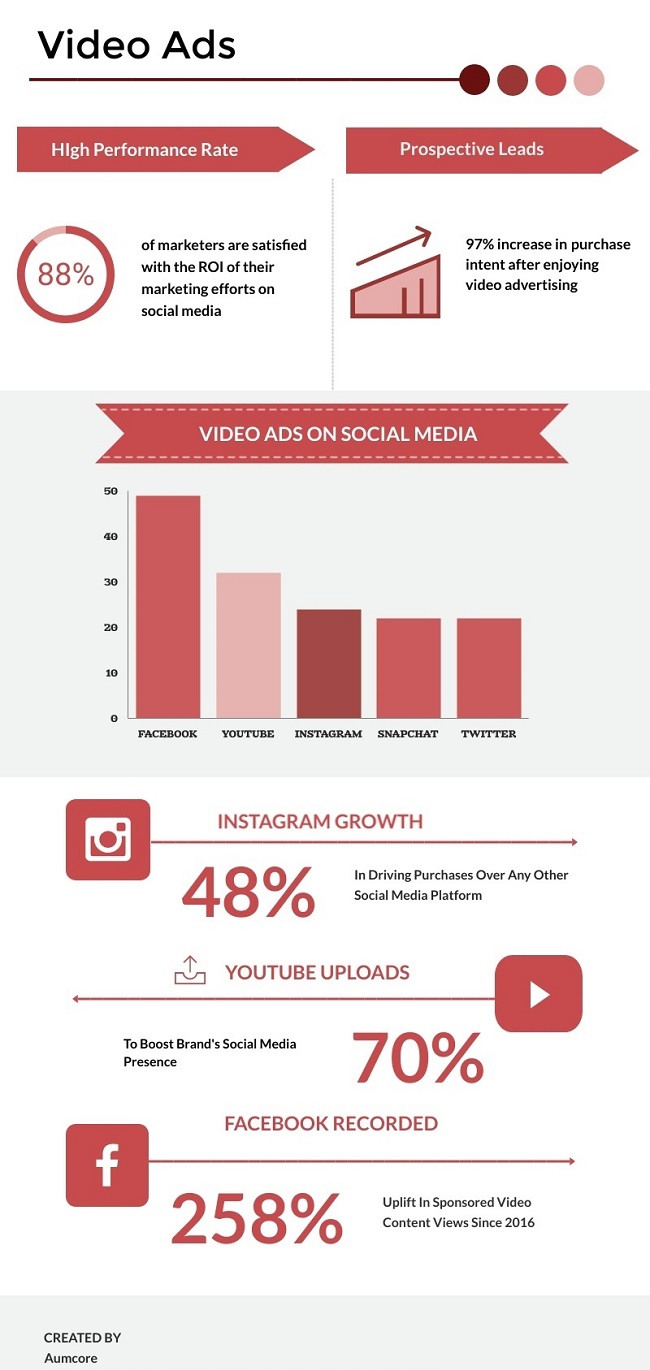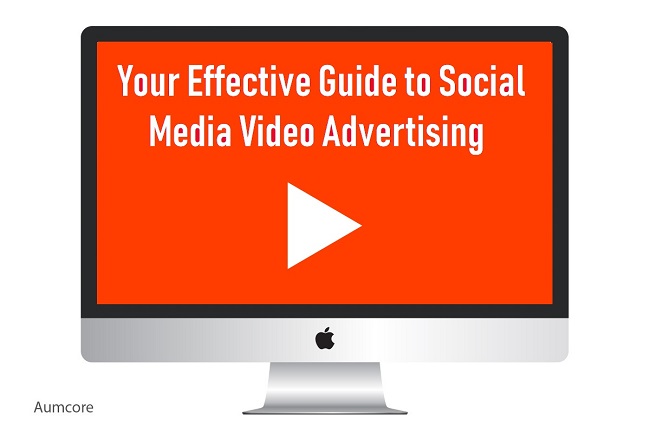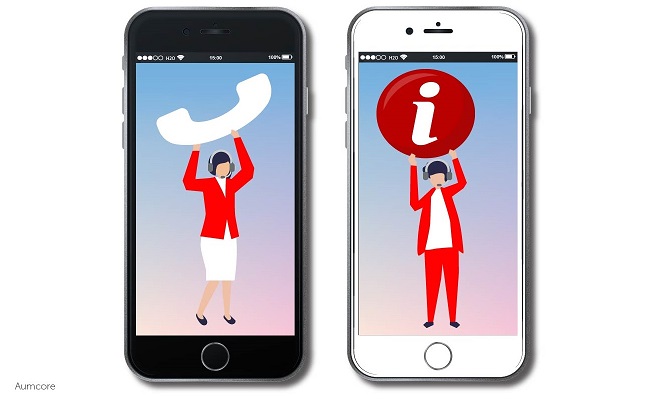Video and social media in 2022 go hand-in-hand. With estimates valuing digital video marketing as a $221.29 billion industry, the power of video advertising is proven by its effectiveness: 93% of businesses gained a new customer as a direct result of a video posted on social media.
In fact, the average video ad view time has increased by 19% in recent years, with more than 50% of consumers saying they prefer video content from brands they support.
In 2021, ad spend on video marketing soared by 49 percent, and we’re expecting a further 26 percent growth by the end of 2022.
Social media video marketing statistics
- 88% of marketers are satisfied with the ROI of their marketing efforts for video on social media
- There is a 97% increase in purchase intent after a prospective lead enjoys a video ad
- 70% of marketers use YouTube to boost their online presence
- Sponsored video content views on Facebook have jumped 258% since 2016
- 26% of marketers say that Stories are their most valuable kind of content on social media

Now that we have established the importance of social media video advertising, let’s move on to the different factors that need to be taken into consideration before executing a video ad campaign. For instance, you have to think about video categories, video types and video format specifications, all of whichare essential components in the video ad creation process.
What is social media video strategy?
A social media video strategy involves creating videos for specific platforms. After all, creating a video for YouTube is very different when compared with creating a video for TikTok. Because of this, you need to carefully consider everything from how the video looks and the length of it to how you are going to market it effectively.
What is a video marketing strategy?
What is video advertising? Video marketing strategies cover everything relating to creating, curating, and using video as a means of advertising your products or services to your target audience.
Importance of video content on social media
Creating video content on social media is critical so that you can connect with users. When you consider how many people use social media today, video is a great way of reaching others. It is also one of the most shareable content types, so if you create a good video, you can be sure that people will share it with their followers and increase your reach.
Types of online video advertising
There are multiple video types in the market depending on the agenda or message being pursued. Here is a list of the 9 most popular video categories:
There are multiple video types in the market depending on the agenda or message being pursued. Here is a list of the 9 most popular video categories:
- Brand videos
- Explainer videos
- Disappearing videos (social stories)
- Live videos
- How-to videos
- Demo videos
- Expert videos
- Animated videos
- Virtual reality/360° videos
1. Brand Videos
Brand videos are typically created as part of a larger ad campaign, which are displayed on different social media platforms in order to increase traffic and drive brand awareness. The main objective of a brand video is to deliver a brand’s identity, mission, vision, or its products and services to its audience.
2. Explainer Videos
Explainer videos are typically used to demonstrate how a product works, what its functions are, and how its users can benefit from it.
3. Disappearing Videos (Social Stories)
Most social media platforms of today have a function for so-called “time-restricted stories” that effectively capture a user’s attention by creating a sense of urgency. Due to its high audience reach, it is now essential for marketers to know how to use social media stories for business as part of their ad strategies.
4. Live Videos
People spend 8x as much of their time watching live videos as on-demand content. With these high engagement rates, these real-time videos are quickly being integrated into many social media video advertising strategies.
Read More About: How to Use Video Storytelling in Your Marketing Strategy
5. How-to Videos
70% of millennial Youtube users watched “how-to” videos for learning purposes. These videos effectively demonstrate a product or service’s functions and establish a closer relationship with prospective clients.
6. Demo Videos
Demo videos have a similar goal as explainer and how-to videos, but take things further by emphasizing all the key benefits of the company’s products or services.
7. Expert Videos
Expert videos are interviews delivered by influencers who are perceived as more credible. Thus, expert videos are especially useful in creating trust between a brand and it target audience.
8. Animated Videos
Animated videos can be used efficiently to explain complicated or abstract concepts, while retaining an eye-catching and entertaining quality.
9. Virtual Reality/360° Videos

Even though virtual reality (VR) videos are relatively new compared to other video types, their demand is increasing among viewers. After all, these videos are often seen as a novelty. However, as the technology develops, they’re sure to become a more integral and interactive part of video marketing.
Digital Video Ad Formats
From ad types, we arrive at digital video ad formats. According to the Interactive Advertising Bureau, there are two main formats for digital video ads that can include a companion banner ad: linear and nonlinear.
- Linear Video Ads
- This ad format interrupts streaming video content
- Played before (pre-roll), during (mid-roll), or after (post-roll) the streaming content
- Can be served with companion ads (below)
- Can include an interactive content
- Nonlinear Video Ads
- This ad format displays as a static image, text, or interactive rich media overlayed on the video content
- Runs simultaneously with the streaming content
- Can be served with companion ads (below)
Companion Video Ads
- Companion video ads are always served with the master ad (linear or nonlinear)
- Runs alongside or surrounding the video player
- Comes in a number of shapes and sizes
- Retains visibility of the sponsor throughout the streaming video experience
The Four Steps in the Video Ad Creation Process
It’s time to cover the actual video ad creation process, which consists of four stages, described below:

1. Concept Development
The first step in the video ad creation process is to identify which concept and agenda you want to pursue. Different variables like video type, category or social media channel should be taken into consideration in this step. In order to determine which approach to take, it’s also essential to have intimate knowledge of your target audience.
2. Video Creation
Once all the factors of the concept development stage are analyzed, it’s time to create the video. This will be a time-consuming process because there’s a lot of planning involved, and a lot of moving variables to consider. You will need to establish sets, set casting calls, create a script, and perform a lot of other prerequisites before the actual video shooting can begin. If you are creating an animated video, there will be even more steps to include before the actual video creation, such as the pre-production and storyboard stages.
Tip: Video creation is a tedious business. Feel free to reach out to your friendly neighborhood video marketing agency for some help!
3. Video Editing
There are a lot of editing elements involved in the video editing stage, such as:
- Visual effects
- Text overlay
- Sound effects
- Closed captions
- Lighting
- Etc.
Depending on which video type or category you choose, more editing might be needed.
4. Ad Creation
As the fourth and final step, the creation of the actual ads for each social media platform will take place after the video is made. Once the ads are running, it’s vital to keep a close eye on them and analyze any key performance indicators (KPIs) you’ve established.
Social Media Video Advertising Specifications
Each social media platform requires its own unique video specifications when it comes to uploading content. Because Facebook, Youtube, and Instagram are the most effective channels for video advertising, here’s a quick summary of video specs for each one:
Here are the specifications for Facebook video ads:
- Feed video:
- Size: 1280 x 720 px
- Minimum size: 600 px (width)
- Supported aspect ratio: 16:9 (full landscape) / 1:1 (square) / 4:5 (vertical) / 2:3 (vertical) / 9:16 (full portrait)
- Specs: MP4 or MOV format / maximum length of 240 minutes / maximum file size of 4 GB
- Placement: Natively on Facebook Feed
- In-stream video:
- Size: 1280 x 720 px
- Minimum size: 600 x 315 px or 600 x 600 px
- Supported aspect ratio: 16:9 (full landscape) / 1:1 (square) / 4:5 (vertical) / 2:3 (vertical) / 9:16 (full portrait)
- Specs: MP4 or MOV format / maximum length of 15 seconds / maximum file size of 4 GB
- Placement: Mid-roll during a video
- Messenger video:
- Size: 1280 x 720 px
- Supported aspect ratio: 16:9 (horizontal) to 1.91:1 (horizontal)
- Specs: MP4 or MOV format / maximum length of 240 minutes / maximum file size of 4 GB
- Placement: Natively on Facebook Messenger through Home or Sponsored Messages
- Carousel video:
- Size: 1080 x 1080 px
- Minimum size: 600 x 600 px
- Supported aspect ratios: 1:1 (square)
- Specs: MP4 or MOV format / maximum length of 240 minutes / maximum file size of 4 GB / between two and 10 videos
- Placement: Natively on Facebook Feed, Marketplace, or Instant Articles
Here are the specifications for Instagram video ads:
- In-feed video
- Size: 600 x 600 px (square) / 600 x 315 px (horizontal) / 600 x 750 px (vertical)
- Supported aspect ratios: 1:1 (square) / 1.9:1 (horizontal) / 4:5 (vertical)
- Specs: MP4 or MOV format / maximum length of 60 seconds / maximum file size of 4 GB
- Placement: Natively on Instagram Feed
- Carousel video:
- Size: 1080 x 1080 px
- Minimum size: 600 x 600 px
- Supported aspect ratios: 1:1 (square)
- Specs: MP4 or MOV format / maximum length of 60 seconds
- Placement: Natively on Instagram Feed
- Stories video:
- Size: 1080 x 1920 px
- Minimum size: 600 x 1067 px
- Supported aspect ratio: 16:9 to 4:5 and 9:16
- Specs: MP4 or MOV format / maximum length of 60 seconds / maximum file size of 4 GB
- Placement: Between Instagram Stories
YouTube
Here are the specifications for YouTube video ads:
- Video player
- Size: 426 x 240 px (240p) / 640 x 360 px (360p) / 854 x 480 px (480p) / 1280 x 720 px (720p) / 1920 x 1080 px (1080p) / 2560 x 1440 px (1440p) / 3840 x 2160 px (2160p)
- Minimum size: 426 x 240 px
- Maximum size: 3840 x 2160 px
- Supported aspect ratio: 16:9 and 4:3
- Specs: MOV, MPEG4, MP4, AVI, WMV, MPEG-PS, FLV, 3GPP, or WebM / maximum length of 12 hours / maximum file size of 128 GB
Final Thoughts
Like most marketing endeavors, video marketing comes with its own set of challenges that must be overcome, especially with video on social media. So, how do you make effective video ads on Facebook? By following everything we covered today, which can serve as an aid to guide you through everything. Let’s take a second look at the main points:
- Identify your target market and main objectives
- Choose your video type, category, and format specifications
- Follow the video ad creation process guide
- Establish KPIs
- Monitor and optimize your data




